#artist is sir edwin henry landseer
Explore tagged Tumblr posts
Text


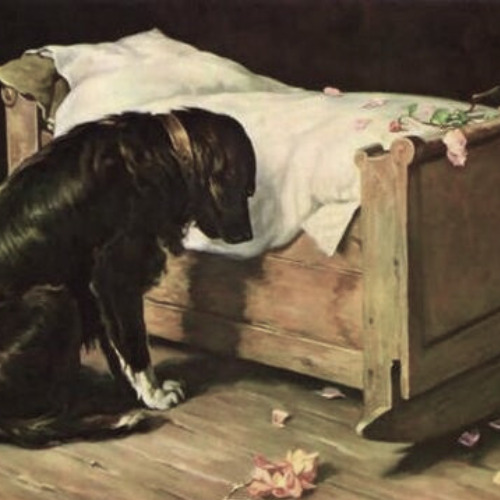

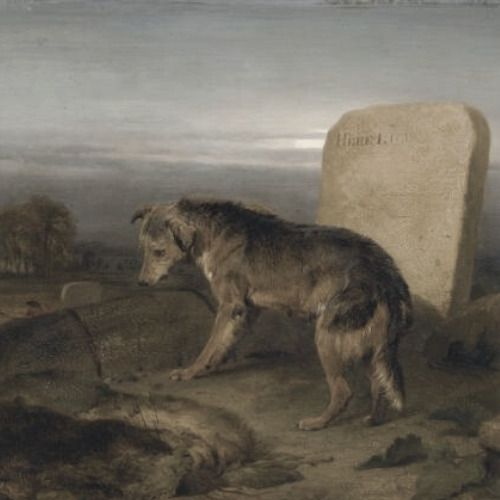

loyal in life, loyal in death
#artist is sir edwin henry landseer#-artist is sir edwin henry landseer#artist is gustave henry mosler#artist is briton riviere#--artist is edwin henry landseer#artist is charles christian nahl#art#artedit#art history#arthistoryedit#animals#dogs
537 notes
·
View notes
Text



▪︎ Attachment.
Artist: Sir Edwin Henry Landseer (English, 1802–1873)
Date: 1829
Place of origin: Cumbria, England
Medium: Oil on canvas
#19th century#19th century art#art#history#decorative arts#history of art#art history#oil painting#attachment#dog#love#dedication#sir Edwin Henry Landseer#cumbria#1829
52 notes
·
View notes
Text

Shoeing the Bay Mare
Artist: Sir Edwin Henry Landseer
1 note
·
View note
Text

Study of a Lion. Sir Edwin Henry Landseer. c. 1862 C.E. Oil on canvas.
#sir edwin henry landseer#19th century#1860s#canvas#oil#painting#art history#artist: british#lion#painting study
29 notes
·
View notes
Text
Sir Edwin Landseer Letter to M. Nupell (1837)
Sir Edwin Landseer Letter to M. Nupell (1837)

In this short letter to a M. Nupell (?), the British artist poses an odd request for a presumed acquaintance or friend. It’s the 1837-equivalent to a random “hey you still got that one thing” text.
Bonus: Landseer even includes a quick sketch- perhaps an early predecessor to the modern-day emoji?
(more…)
View On WordPress
2 notes
·
View notes
Text
8 Great Facts About the Newfoundland Dog
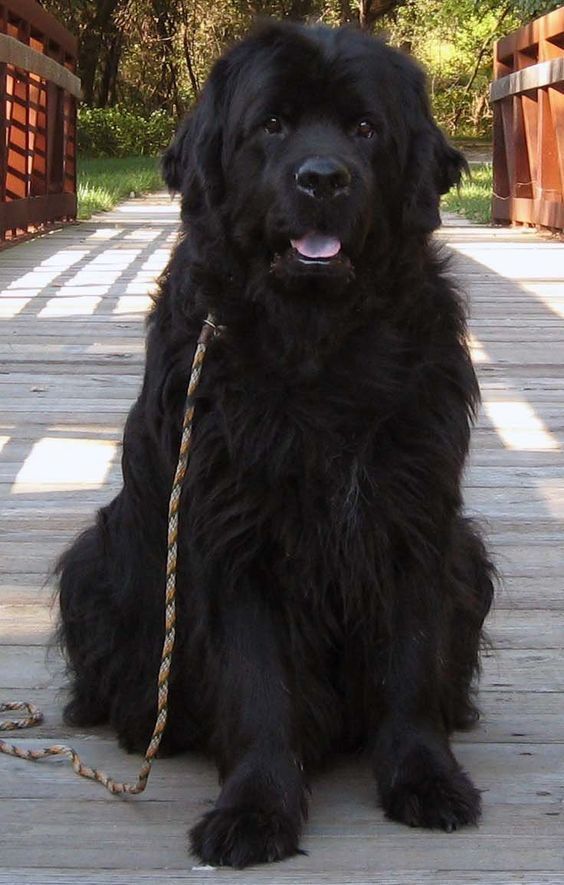
He is the black bear of the dog world, but his imposing size and appearance belies a kind nature and a long history of service to mankind. Here are eight fun facts about the noble Newfoundland dog.

1. The Newfoundland Dog’s Canadian Origins
The Newfoundland dog did indeed originate in the Dominion of Newfoundland (now a province of Canada), where he was used as a working dog by fishermen. He descended from a breed native to the island and known as the Lesser Newfoundland or the St. John’s Dog.
DNA analysis confirms that the breed is also closely related to other Canadian retrievers like the Labrador and the Nova Scotia Duck Tolling Retriever. The Newfoundland shares many physical traits (huge head, broad muzzle, stout legs) with the Mastiff and Molosser-type breeds such as the St. Bernard. This was likely due to the introduction of Mastiff blood, probably from matings with Portuguese Mastiffs, which were brought to the island by Portuguese fishermen beginning in the 16th century.
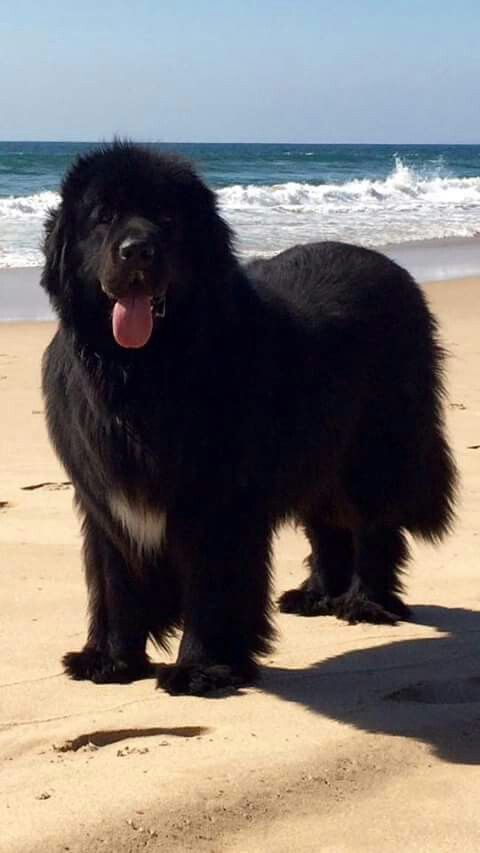
2. The Newfoundland loves water
The Newfoundland excels at water rescue and lifesaving, thanks to his muscular build, thick double coat, webbed feet and innate swimming ability. The breed’s large bones and massive size give it the power to handle choppy ocean waves and strong tides.
Newfoundlands have a huge lung capacity for swimming long distances. The oily, waterproof coat keeps a Newfoundland dog dry and protects them from the chill of icy waters. The breed’s history is replete with examples of courage demonstrated by the Newfoundland in lifesaving exploits. One particularly famous Newfoundland was “Seaman,” who accompanied American explorers Lewis and Clark on their expedition.
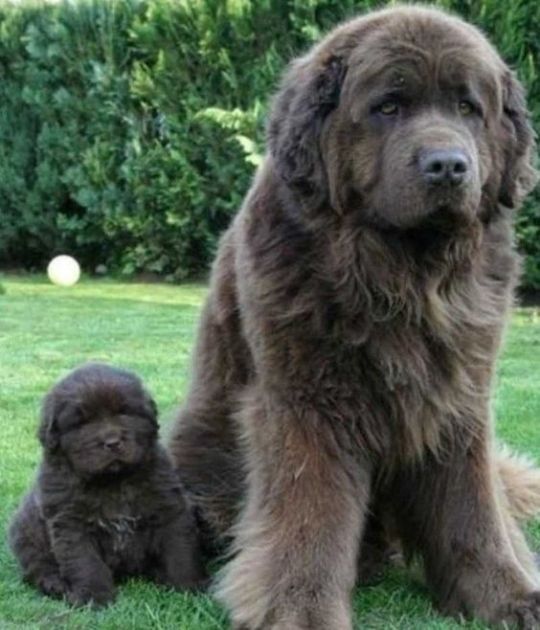
3. The Newfoundland’s breed standard
The Newfoundland’s lifesaving prowess would not be possible were it not for the breed’s kind nature. The American Kennel Club breed standard says it in the most emphatic way: “Sweetness of temperament is the hallmark of the Newfoundland; this is the most important single characteristic of the breed.” The standard starts out with the following description under “General Appearance: The Newfoundland is a sweet-dispositioned dog that acts neither dull nor ill-tempered. He is a devoted companion. A multipurpose dog, at home on land and in water, the Newfoundland is capable of draft work and possesses natural lifesaving abilities.”
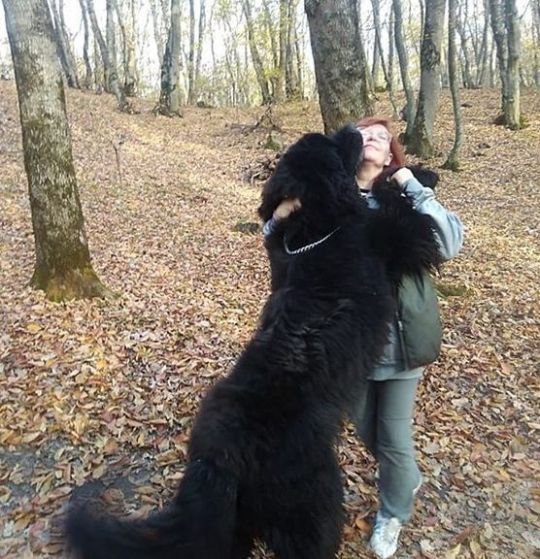
4. A bear-like breed
A typical adult Newfoundland male stands 28 inches at the shoulder; 26 inches at the shoulder for an adult female. This is also a very heavy, substantial breed, with adult males ranging from 130 to 150 pounds; adult females from 100 to 120 pounds. For all his size, however, the Newfoundland dog is a mellow fellow and doesn’t require a huge amount of room to be happy. Adults will typically spend much of the day napping. While many a child has learned to walk grabbing hold of a Newfoundland, active puppies can easily bowl over a toddler, so adult supervision is recommended.

5. Some Newfoundland dogs are black and white
While the majority of Newfoundlands are solid black, perhaps with a touch of white on the chin, chest and toes, it is the white Newfoundland with black markings that boasts a lasting artistic connection. As an homage to the famous English painter, Sir Edwin Henry Landseer, who often chose the black-and-white Newfoundland dog as the subject of his works, this color pattern is known as the Landseer. There are also solid brown and solid gray Newfoundlands.
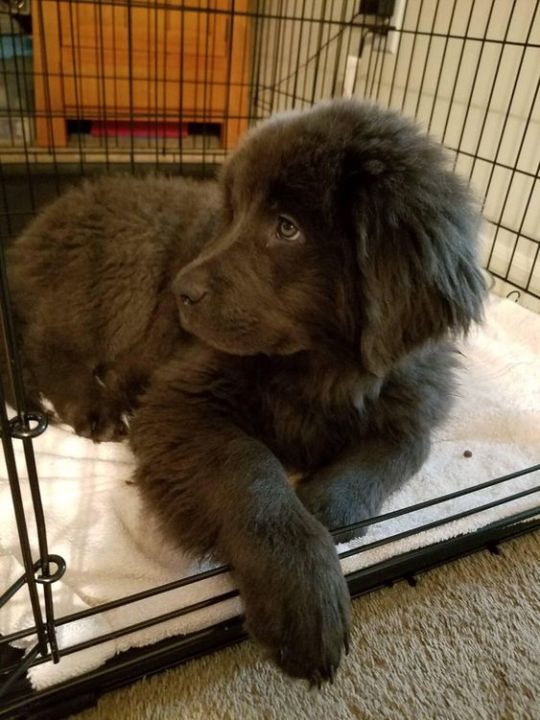
6. Newfoundlands in pop culture
Although Newfoundlands are often encountered in books and art, the most famous Newfoundland dog in literature is easily “Nana,” the faithful protector of the Darling children in J.M. Barrie’s Peter Pan. Robert Kennedy’s family was devoted to Newfoundlands and many casual photos of the young Kennedy children feature a Newfoundland lovingly watching over them.

7. Newfoundland dogs have won at Westminster twice
Many breeds are still waiting impatiently for their day to win Best in Show at the Westminster Kennel Club, the most prestigious dog show in America that takes place every year. Newfoundlands have triumphed twice: “Adam,” more formally known as Champion Seaward’s Blackbeard, claimed the top prize in 1984 and, two decades later, it was “Josh,” Champion Darbydale’s All Rise Pouch Cove, who stole the spotlight in 2004.

8. Newfoundlands and Water Dog titles
To honor the Newfoundland’s illustrious history of lifesaving and to appreciate the fun of seeing the dogs doing what should come naturally to them, the Newfoundland Club of America designed rescue and water dog tests. In the Junior Division, Newfoundlands are required to retrieve a bumper, a life jacket or cushion, deliver a rope to a swimming steward, tow a boat and swim calmly with a handler. Performing these and other exercises earns the Newfoundland a Water Dog title.
The exercises get more challenging in the Senior Division, and to earn the Water Rescue Dog title the dog must retrieve two articles in the proper order, leap from a boat to fetch a paddle, carry a life ring to a swimmer in “distress,” retrieve underwater, tow a boat to shore and leap from a boat to save his handler who has “fallen” overboard. There is even a third division for elite working dogs that compete for the Water Rescue Dog Excellent title.

154 notes
·
View notes
Photo

Edwin Landseer’s Cursed Painting
The painting above is an almost 200-year-old oil painting titled “Man Proposes, God Disposes”, the credited artist being Edwin Henry Landseer. It was inspired by Sir John Franklin’s failed expedition to the Northwest Passage, a journey where 129 of the 134 explorers disappeared without a trace (supposedly devoured by polar bears). The painting was sold Royal Holloway, University of London in 1881. Students believed the painting to be haunted, alleging that a student in the 1920-30s gouged their eyes out with a pencil and committed suicide after, stating that “the polar bears made them do it” on their test. It’s been a bad omen since to look at the painting while you’re testing.
#man proposes god disposes#edwin landseer#cursed#cursed art#cursed paintings#polar bears#nautical#nautical tales#urban legends#lighthousecore#aquatic themes
57 notes
·
View notes
Text
Joseph Wolf (22 January 1820 – 20 April 1899) was a German artist who specialized in natural history illustration. He moved to the British Museum in 1848 and became the preferred illustrator for explorers and naturalists including David Livingstone, Alfred Russel Wallace and Henry Walter Bates. Wolf depicted animals accurately in lifelike postures and is considered one of the great pioneers of wildlife art. Sir Edwin Landseer thought him "...without exception, the best all-round animal artist who ever lived".

A red deer stag rutting on a hill by Balmoral Castle by Joseph Wolf (1863)
2K notes
·
View notes
Text
Victorian Style Antique Oil Painting Early 19th C.
Victorian Style Fine Art Oil On Canvas Painting Beautiful Houses Scottish Landscape After Sir Edwin Henry Landseer. Oil on canvas painting in the style of similar to after Sir Edwin Henry Landseer. No signature unsigned by an unknown master artist. Subject depicting a a pair of houses in Scottish mountainous pastoral landscape. Delightful masterpiece so pleasing to the eye. A superb collectors item. Offered in fine used condition. Having some noticeable wear, scuffs and some minor chips to the frame with some staining and streaks to the canvas front surface in places with foxing on the back commensurate with usage & age. Some foxing staining to the back of the canvas in places. Set in a beautiful gilt frame. With hanging thread on the back ready for home display. Circa Early 19th century 1970’s.
Sir Edwin Henry Landseer RA 7 March 1802 – 1 October 1873 was an English painter and sculptor. Well known for his paintings of animals particularly horses, dogs, and stags. However, his best known works are the lion sculptures in Trafalgar Square Landseer was born in London, the son of the engraver John Landseer A.R.A.
Free International worldwide shipping is available. Viewings are welcome by appointment only for customer support please send a message
URL
https://antiqueonsale.com/product/victorian-style-antique-oil-painting-early-19th-c-antique-store-savannah-ga/

#tumblrphoto#tumblrgirls#tumblrquotes#tumblrposts#tumblrtextpost#tumblraesthetic#tumblrpost#tumblrboy#tumblrgirl
0 notes
Text
Museum of the Dog
New York’s New Museum of the Dog Is Serving Canine Realness Extravaganza
The American Kennel Club’s Museum of the Dog is now open to the public at 101 Park Avenue, New York City.

Maud Earl, “Ch. Nunsoe Duc de la Terrace of Blakeen” (1935), oil on board
There are dogs on Instagram who make more money than you. Some have modeling contracts and sponsorship deals; others have even won acting awards. Research also indicates that canines have a proverbial leg up on felines, eclipsing them in online searches as early as 2014. And despite what the sudden arrival of cat cafés across New York might imply, the city boasts a dog population that’s 20% higher than their whiskered colleagues, according to data from a 2012 NYECD study.
It should therefore come as no surprise that New York now boasts a two-story museum in midtown devoted to dogs. The galleries are stuffed to the brim with oodles of poodles and painted Pomeranians. But are these artworks worthy of, say, Pugcasso — or are they just plain Shih Tzu?

Returning to the city after a 30-year stint in the suburbs of St. Louis, Missouri, the American Kennel Club’s Museum of the Dog toes the line between brilliant and banal. As the recent parent of my own fur baby (shameless plug), I have little reason to reject an opportunity to bask in the cuteness of a few dozen portraits of good boys and girls. But the art critic within me expects much more from a museum than images of moody poodles by the seashore. Rest assured, there are a handful of bright spots in the AKC’s art collection, but the current curatorial program is overwrought in its emphasis on dog gravitas and regality.

Perhaps this is an overcorrection set against the art history of dogs, which often fails to give pups the same opportunities that kittens have. Certainly, there are no dog masterpieces on par with something like Édouard Manet’s “Olympia” (1863), which features a very prickly (and symbolically charged) black cat. And major museums have planned no paeans to canines on the same scale as something like the Brooklyn Museum’s long-term exhibition, Divine Felines: Cats of Ancient Egypt. Art criticism, too, is a cat’s game with many writers pushing this whiskered agenda forward.

The Museum of the Dog has a taste for overly serious portraiture. Black terriers sit upright on their cushiony thrones while bloodhounds bathe in the chiaroscuro light of a watery hunting scene. Attention to the macabre in dog portraiture began in earnest in the 19th century, when the genre got its biggest boost from Queen Victoria. Throughout her lifetime, the monarch owned 10 dogs in addition to Shetland ponies, goats, and parrots. (Keep in mind, this list is nothing to Queen Elizabeth II’s cohort of 30 corgis since rising to the throne in 1952.) Paintings of the former queen’s pets were so widely circulated that they became the subject of parody. George Henry Hall’s 1849 painting “The Levee” refers to the ritual attendance of King Louis XIV’s court to the French ruler’s morning waking; nevertheless, the composition mimics Sir Edwin Landseer’s 1838 portrait of Queen Victoria’s animals, titled “Her Majesty’s Favourite Pets.” Subtle with its humor, Hall’s portrait ridicules the pomp and circumstance of royalty by casting spaniels and greyhounds in the roles of nobility. With puffed chests and anxious looks, the dogs’ obvious impatience lampoons the self-stifling traditions of the royal class.
Scattered throughout the museum are crowd-pleasing technological diversions like an augmented realty game of fetch with a cartoon dog. Upon first arriving to the museum, most visitors will likely head straight for the touch-screen monolith that matches your photo with the dog breed you most resemble. (The program identified me as a German Pinscher, which it describes as “vivacious” among other adjectives. Dear reader, under no uncertain terms has anyone ever described me as “vivacious.”)
Evolutionary biology teaches us that dogs are the descendants of wolves. Artists in the late 19th century increasingly featured canines in their hunting scenes as symbolic of man’s connection to the wild decades after the Industrial Revolution polluted the land and enticed rural villagers to the cityscape for factory jobs. With that context in mind, Richard Ansdell’s “Highland Tod, Fox Hunter” (1859) makes a lot more sense. The painting includes a garrison of 14 dogs and nine humans traveling through what appear to be the Scottish Highlands. A visual encyclopedia of the era’s most popular British breeds, the work features collies, hounds, and terriers. More dramatic is the artist’s 1865 painting of an enormous mastiff, called “The Poacher.” Here, a man wrestles to control his giant dog, having just fallen on a sack of slain birds and rabbits. The mastiff looks into the distance with bleary eyes as his owner sternly grips his collar.

Richard Ansdell, “Highland Tod, Fox Hunter” (1859), oil on canvas
Elsewhere though, the museum reminds us how humans have engineered dogs for centuries. Where would the American Kennel Club be, after all, if it wasn’t for these canine eugenics projects that have resulted in hundreds of different breeds? (The organization officially recognizes only 192 dog breeds from an estimated 340 known throughout the world.) On the museum’s second floor are two paintings hung together for the sake of juxtaposition: “Ch. Nornay Sadler” (1940) by Edwin Megargee and “The Totteridge XI,” (1897) by Arthur Wardle. The latter work depicts a smooth fox terrier with anatomical precision, making the dog an ideal of the breed. The painting below depicts nearly a dozen other fox terriers, all imperfect attempts at achieving the perfection displayed above.

Christine Merrill, “Millie on the South Lawn” (1990), oil on board
Still, I have hope that the museum will use its new square footage to execute more ambitious exhibitions in the future. Where are William Wegman’s Weimaraner photographs? What happened to Picasso’s adopted dog, Lump. And we need shows devoted to presidential dogs. (A portrait of George HW Bush’s English Springer Spaniel is here, but what about Lyndon B. Johnson’s beagle or Barack Obama’s Portuguese Water Dog?) Throw this strange side of political history a bone!

0 notes
Text

A Scene at Abbotsford. Sir Edwin Henry Landseer. est. c. 1827 C.E. Oil on wood.
16 notes
·
View notes
Photo

Singerie is the name given to a visual arts genre depicting monkeys imitating human behavior. This Painting is by: HIPPOLITE BOUG D'ORSCHWILLER "The Monkey and the Cat" 22 X 25 cm Available for only Price: 1,000 € Monkeys imitating human behavior. often fashionably attired, intended as a diverting sight, always with a gentle cast of mild satire. The term is derived from the French word for "Monkey Trick". Singeries regained popularity in the 19th century and artists then successful in this genre included Zacharie Noterman, Emmanuel Noterman, Sir Edwin Henry Landseer, Edmund Bristow, Alexandre-Gabriel Decamps, Charles Monginot and Paul Friedrich Meyerheim and also this artist HIPPOLITE BOUG D'ORSCHWILLER was one of them.(1810 - 1868) Hippolyte De Bourg d'Orschwiller - This work by Hippolyte De Bourg d'Orschwiller - shows a view of a monkey and the cat in a Kitchen, moving brushwork representation in muted soft color. Hippolyte de Boug D ?? Orschwiller presented 1834-1864 from repeated animal pieces and Swiss views at the Paris Salon. Since 1857, he painted, influenced by Decamps, numerous monkeys pieces. Examples can be found among others in the museums in Bern and Posen. #19thcenturypainting #french #swiss #figurativeart #19thcenturyacademicart #generepainting #frenchacademicart #monkey #monkeytrick #artworkvision #michelstichter https://www.instagram.com/p/Bs21RCbHuel/?utm_source=ig_tumblr_share&igshid=tckjdtovbzt
#19thcenturypainting#french#swiss#figurativeart#19thcenturyacademicart#generepainting#frenchacademicart#monkey#monkeytrick#artworkvision#michelstichter
0 notes
Text
Image taken from page 359 of 'Christmas Books ... With illustrations by Sir Edwin Landseer, R.A., Maclise, R.A., Stanfield, R.A., F. Stone, Doyle, Leech, and Tenniel'

Image taken from: Title: "Christmas Books ... With illustrations by Sir Edwin Landseer, R.A., Maclise, R.A., Stanfield, R.A., F. Stone, Doyle, Leech, and Tenniel", "Single Works. Christmas Books" Author: Dickens, Charles Contributor: DOYLE, Richard. Contributor: Landseer, Edwin Henry - Sir Contributor: LEECH, John - Artist Contributor: MACLISE, Daniel. Contributor: STANFIELD, William Clarkson. Contributor: STONE, Francis - Artist Contributor: Tenniel, John - Sir Shelfmark: "British Library HMNTS 12620.dd.6." Page: 359 Place of Publishing: London Date of Publishing: 1869 Publisher: Chapman & Hall Issuance: monographic Identifier: 000931281 Explore: Find this item in the British Library catalogue, 'Explore'. Download the PDF for this book (volume: 0) Image found on book scan 359 (NB not necessarily a page number) Download the OCR-derived text for this volume: (plain text) or (json) Click here to see all the illustrations in this book and click here to browse other illustrations published in books in the same year. Order a higher quality version from here. from BLPromptBot http://bit.ly/2QKCAgB
0 notes
Text
8 Great Facts About the Newfoundland Dog
8 Great Facts About the Newfoundland Dog http://bit.ly/2UksOrS
The post 8 Great Facts About the Newfoundland Dog by Allan Reznik appeared first on Dogster. Copying over entire articles infringes on copyright laws. You may not be aware of it, but all of these articles were assigned, contracted and paid for, so they aren't considered public domain. However, we appreciate that you like the article and would love it if you continued sharing just the first paragraph of an article, then linking out to the rest of the piece on Dogster.com.
He is the black bear of the dog world, but his imposing size and appearance belies a kind nature and a long history of service to mankind. Here are eight fun facts about the noble Newfoundland dog.
1. The Newfoundland Dog’s Canadian Origins
Newfoundland dog on a Canadian stamp. Photography ©microstocker | Getty Images.
The Newfoundland dog did indeed originate in the Dominion of Newfoundland (now a province of Canada), where he was used as a working dog by fishermen. He descended from a breed native to the island and known as the Lesser Newfoundland or the St. John’s Dog. DNA analysis confirms that the breed is also closely related to other Canadian retrievers like the Labrador and the Nova Scotia Duck Tolling Retriever. The Newf shares many physical traits (huge head, broad muzzle, stout legs) with the Mastiff and Molosser-type breeds such as the St. Bernard. This was likely due to the introduction of Mastiff blood, probably from matings with Portuguese Mastiffs, which were brought to the island by Portuguese fishermen beginning in the 16th century.
2. The Newfoundland loves water
The Newfoundland excels at water rescue and lifesaving, thanks to his muscular build, thick double coat, webbed feet and innate swimming ability. The breed’s large bones and massive size give it the power to handle choppy ocean waves and strong tides. Newfs have a huge lung capacity for swimming long distances. The oily, waterproof coat keeps a Newfoundland dog dry and protects them from the chill of icy waters. The breed’s history is replete with examples of courage demonstrated by the Newfoundland in lifesaving exploits. One particularly famous Newf was “Seaman,” who accompanied American explorers Lewis and Clark on their expedition.
3. The Newf’s breed standard
The Newfoundland’s lifesaving prowess would not be possible were it not for the breed’s kind nature. The American Kennel Club breed standard says it in the most emphatic way: “Sweetness of temperament is the hallmark of the Newfoundland; this is the most important single characteristic of the breed.” The standard starts out with the following description under “General Appearance: The Newfoundland is a sweet-dispositioned dog that acts neither dull nor ill-tempered. He is a devoted companion. A multipurpose dog, at home on land and in water, the Newfoundland is capable of draft work and possesses natural lifesaving abilities.”
4. A bear-like breed
A typical adult Newfoundland male stands 28 inches at the shoulder; 26 inches at the shoulder for an adult female. This is also a very heavy, substantial breed, with adult males ranging from 130 to 150 pounds; adult females from 100 to 120 pounds. For all his size, however, the Newfoundland dog is a mellow fellow and doesn’t require a huge amount of room to be happy. Adults will typically spend much of the day napping. While many a child has learned to walk grabbing hold of a Newfoundland, active puppies can easily bowl over a toddler, so adult supervision is recommended.
5. Some Newfoundland dogs are black and white
While the majority of Newfs are solid black, perhaps with a touch of white on the chin, chest and toes, it is the white Newf with black markings that boasts a lasting artistic connection. As an homage to the famous English painter, Sir Edwin Henry Landseer, who often chose the black-and-white Newfoundland dog as the subject of his works, this color pattern is known as the Landseer. There are also solid brown and solid gray Newfs.
6. Newfs in pop culture
Although Newfoundlands are often encountered in books and art, the most famous Newfoundland dog in literature is easily “Nana,” the faithful protector of the Darling children in J.M. Barrie’s Peter Pan. Robert Kennedy’s family was devoted to Newfs and many casual photos of the young Kennedy children feature a Newf lovingly watching over them.
7. Newfoundland dogs have won at Westminster twice
Many breeds are still waiting impatiently for their day to win Best in Show at the Westminster Kennel Club, the most prestigious dog show in America that takes place every February at Madison Square Garden in New York City. Newfoundlands have triumphed here twice: “Adam,” more formally known as Champion Seaward’s Blackbeard, claimed the top prize in 1984 and, two decades later, it was “Josh,” Champion Darbydale’s All Rise Pouch Cove, who stole the spotlight in 2004.
8. Newfs and Water Dog titles
Newfoundlands can excel at swimming due to their muscular build, thick double coat, webbed feet and innate swimming ability. Photography ©stanfram | Getty Images.
To honor the Newfoundland’s illustrious history of lifesaving and to appreciate the fun of seeing the dogs doing what should come naturally to them, the Newfoundland Club of America designed rescue and water dog tests. In the Junior Division, Newfs are required to retrieve a bumper, a life jacket or cushion, deliver a rope to a swimming steward, tow a boat and swim calmly with a handler. Performing these and other exercises earns the Newf a Water Dog title.
The exercises get more challenging in the Senior Division, and to earn the Water Rescue Dog title the dog must retrieve two articles in the proper order, leap from a boat to fetch a paddle, carry a life ring to a swimmer in “distress,” retrieve underwater, tow a boat to shore and leap from a boat to save his handler who has “fallen” overboard. There is even a third division for elite working dogs that compete for the Water Rescue Dog Excellent title.
About the author
Allan Reznik is a journalist, editor and broadcaster who specializes in dog-related subjects. He is the former editor-in-chief of Dogs in Review and former editor of Dog Fancy magazine. A city dweller all his life, on both coasts, he now enjoys the rural South with his Afghan Hounds, Tibetan Spaniels and assorted rescues.
Editor’s note: This article appeared in Dogster magazine. Have you seen the new Dogster print magazine in stores? Or in the waiting room of your vet’s office? Subscribe now to get Dogster magazine delivered straight to you!
Why read breed profiles?
Dog breed profiles help everyone, whether you have a mixed breed or purebred dog, to better understand and improve the quality of your dog’s life. If you have a mixed breed dog, read up on all of the breed profiles that make up your dog. Not sure what breed your dog is? There are a number of easy DNA tests out there to help your find out.
Read more about dog breeds on Dogster.com:
5 Lovable & Lazy Dog Breeds
The Chinese Shar-Pei — 8 Fun Facts
What to Know About the Boxer Dog Breed
The post 8 Great Facts About the Newfoundland Dog by Allan Reznik appeared first on Dogster. Copying over entire articles infringes on copyright laws. You may not be aware of it, but all of these articles were assigned, contracted and paid for, so they aren't considered public domain. However, we appreciate that you like the article and would love it if you continued sharing just the first paragraph of an article, then linking out to the rest of the piece on Dogster.com.
via Dogster https://poop4u/blog April 18, 2019 at 08:54AM DMT.NEWS, @Allan Reznik, @pooop4u April 18, 2019 at 02:32PM
0 notes
Text
8 Great Facts About the Newfoundland Dog
The post 8 Great Facts About the Newfoundland Dog by Allan Reznik appeared first on Dogster. Copying over entire articles infringes on copyright laws. You may not be aware of it, but all of these articles were assigned, contracted and paid for, so they aren’t considered public domain. However, we appreciate that you like the article and would love it if you continued sharing just the first paragraph of an article, then linking out to the rest of the piece on Dogster.com.
He is the black bear of the dog world, but his imposing size and appearance belies a kind nature and a long history of service to mankind. Here are eight fun facts about the noble Newfoundland dog.
1. The Newfoundland Dog’s Canadian Origins
Newfoundland dog on a Canadian stamp. Photography ©microstocker | Getty Images.
The Newfoundland dog did indeed originate in the Dominion of Newfoundland (now a province of Canada), where he was used as a working dog by fishermen. He descended from a breed native to the island and known as the Lesser Newfoundland or the St. John’s Dog. DNA analysis confirms that the breed is also closely related to other Canadian retrievers like the Labrador and the Nova Scotia Duck Tolling Retriever. The Newf shares many physical traits (huge head, broad muzzle, stout legs) with the Mastiff and Molosser-type breeds such as the St. Bernard. This was likely due to the introduction of Mastiff blood, probably from matings with Portuguese Mastiffs, which were brought to the island by Portuguese fishermen beginning in the 16th century.
2. The Newfoundland loves water
The Newfoundland excels at water rescue and lifesaving, thanks to his muscular build, thick double coat, webbed feet and innate swimming ability. The breed’s large bones and massive size give it the power to handle choppy ocean waves and strong tides. Newfs have a huge lung capacity for swimming long distances. The oily, waterproof coat keeps a Newfoundland dog dry and protects them from the chill of icy waters. The breed’s history is replete with examples of courage demonstrated by the Newfoundland in lifesaving exploits. One particularly famous Newf was “Seaman,” who accompanied American explorers Lewis and Clark on their expedition.
3. The Newf’s breed standard
The Newfoundland’s lifesaving prowess would not be possible were it not for the breed’s kind nature. The American Kennel Club breed standard says it in the most emphatic way: “Sweetness of temperament is the hallmark of the Newfoundland; this is the most important single characteristic of the breed.” The standard starts out with the following description under “General Appearance: The Newfoundland is a sweet-dispositioned dog that acts neither dull nor ill-tempered. He is a devoted companion. A multipurpose dog, at home on land and in water, the Newfoundland is capable of draft work and possesses natural lifesaving abilities.”
4. A bear-like breed
A typical adult Newfoundland male stands 28 inches at the shoulder; 26 inches at the shoulder for an adult female. This is also a very heavy, substantial breed, with adult males ranging from 130 to 150 pounds; adult females from 100 to 120 pounds. For all his size, however, the Newfoundland dog is a mellow fellow and doesn’t require a huge amount of room to be happy. Adults will typically spend much of the day napping. While many a child has learned to walk grabbing hold of a Newfoundland, active puppies can easily bowl over a toddler, so adult supervision is recommended.
5. Some Newfoundland dogs are black and white
While the majority of Newfs are solid black, perhaps with a touch of white on the chin, chest and toes, it is the white Newf with black markings that boasts a lasting artistic connection. As an homage to the famous English painter, Sir Edwin Henry Landseer, who often chose the black-and-white Newfoundland dog as the subject of his works, this color pattern is known as the Landseer. There are also solid brown and solid gray Newfs.
6. Newfs in pop culture
Although Newfoundlands are often encountered in books and art, the most famous Newfoundland dog in literature is easily “Nana,” the faithful protector of the Darling children in J.M. Barrie’s Peter Pan. Robert Kennedy’s family was devoted to Newfs and many casual photos of the young Kennedy children feature a Newf lovingly watching over them.
7. Newfoundland dogs have won at Westminster twice
Many breeds are still waiting impatiently for their day to win Best in Show at the Westminster Kennel Club, the most prestigious dog show in America that takes place every February at Madison Square Garden in New York City. Newfoundlands have triumphed here twice: “Adam,” more formally known as Champion Seaward’s Blackbeard, claimed the top prize in 1984 and, two decades later, it was “Josh,” Champion Darbydale’s All Rise Pouch Cove, who stole the spotlight in 2004.
8. Newfs and Water Dog titles
Newfoundlands can excel at swimming due to their muscular build, thick double coat, webbed feet and innate swimming ability. Photography ©stanfram | Getty Images.
To honor the Newfoundland’s illustrious history of lifesaving and to appreciate the fun of seeing the dogs doing what should come naturally to them, the Newfoundland Club of America designed rescue and water dog tests. In the Junior Division, Newfs are required to retrieve a bumper, a life jacket or cushion, deliver a rope to a swimming steward, tow a boat and swim calmly with a handler. Performing these and other exercises earns the Newf a Water Dog title.
The exercises get more challenging in the Senior Division, and to earn the Water Rescue Dog title the dog must retrieve two articles in the proper order, leap from a boat to fetch a paddle, carry a life ring to a swimmer in “distress,” retrieve underwater, tow a boat to shore and leap from a boat to save his handler who has “fallen” overboard. There is even a third division for elite working dogs that compete for the Water Rescue Dog Excellent title.
About the author
Allan Reznik is a journalist, editor and broadcaster who specializes in dog-related subjects. He is the former editor-in-chief of Dogs in Review and former editor of Dog Fancy magazine. A city dweller all his life, on both coasts, he now enjoys the rural South with his Afghan Hounds, Tibetan Spaniels and assorted rescues.
Editor’s note: This article appeared in Dogster magazine. Have you seen the new Dogster print magazine in stores? Or in the waiting room of your vet’s office? Subscribe now to get Dogster magazine delivered straight to you!
Why read breed profiles?
Dog breed profiles help everyone, whether you have a mixed breed or purebred dog, to better understand and improve the quality of your dog’s life. If you have a mixed breed dog, read up on all of the breed profiles that make up your dog. Not sure what breed your dog is? There are a number of easy DNA tests out there to help your find out.
Read more about dog breeds on Dogster.com:
5 Lovable & Lazy Dog Breeds
The Chinese Shar-Pei — 8 Fun Facts
What to Know About the Boxer Dog Breed
The post 8 Great Facts About the Newfoundland Dog by Allan Reznik appeared first on Dogster. Copying over entire articles infringes on copyright laws. You may not be aware of it, but all of these articles were assigned, contracted and paid for, so they aren’t considered public domain. However, we appreciate that you like the article and would love it if you continued sharing just the first paragraph of an article, then linking out to the rest of the piece on Dogster.com.
0 notes
Text
8 Great Facts About the Newfoundland Dog
The post 8 Great Facts About the Newfoundland Dog by Allan Reznik appeared first on Dogster. Copying over entire articles infringes on copyright laws. You may not be aware of it, but all of these articles were assigned, contracted and paid for, so they aren’t considered public domain. However, we appreciate that you like the article and would love it if you continued sharing just the first paragraph of an article, then linking out to the rest of the piece on Dogster.com.
He is the black bear of the dog world, but his imposing size and appearance belies a kind nature and a long history of service to mankind. Here are eight fun facts about the noble Newfoundland dog.
1. The Newfoundland Dog’s Canadian Origins
Newfoundland dog on a Canadian stamp. Photography ©microstocker | Getty Images.
The Newfoundland dog did indeed originate in the Dominion of Newfoundland (now a province of Canada), where he was used as a working dog by fishermen. He descended from a breed native to the island and known as the Lesser Newfoundland or the St. John’s Dog. DNA analysis confirms that the breed is also closely related to other Canadian retrievers like the Labrador and the Nova Scotia Duck Tolling Retriever. The Newf shares many physical traits (huge head, broad muzzle, stout legs) with the Mastiff and Molosser-type breeds such as the St. Bernard. This was likely due to the introduction of Mastiff blood, probably from matings with Portuguese Mastiffs, which were brought to the island by Portuguese fishermen beginning in the 16th century.
2. The Newfoundland loves water
The Newfoundland excels at water rescue and lifesaving, thanks to his muscular build, thick double coat, webbed feet and innate swimming ability. The breed’s large bones and massive size give it the power to handle choppy ocean waves and strong tides. Newfs have a huge lung capacity for swimming long distances. The oily, waterproof coat keeps a Newfoundland dog dry and protects them from the chill of icy waters. The breed’s history is replete with examples of courage demonstrated by the Newfoundland in lifesaving exploits. One particularly famous Newf was “Seaman,” who accompanied American explorers Lewis and Clark on their expedition.
3. The Newf’s breed standard
The Newfoundland’s lifesaving prowess would not be possible were it not for the breed’s kind nature. The American Kennel Club breed standard says it in the most emphatic way: “Sweetness of temperament is the hallmark of the Newfoundland; this is the most important single characteristic of the breed.” The standard starts out with the following description under “General Appearance: The Newfoundland is a sweet-dispositioned dog that acts neither dull nor ill-tempered. He is a devoted companion. A multipurpose dog, at home on land and in water, the Newfoundland is capable of draft work and possesses natural lifesaving abilities.”
4. A bear-like breed
A typical adult Newfoundland male stands 28 inches at the shoulder; 26 inches at the shoulder for an adult female. This is also a very heavy, substantial breed, with adult males ranging from 130 to 150 pounds; adult females from 100 to 120 pounds. For all his size, however, the Newfoundland dog is a mellow fellow and doesn’t require a huge amount of room to be happy. Adults will typically spend much of the day napping. While many a child has learned to walk grabbing hold of a Newfoundland, active puppies can easily bowl over a toddler, so adult supervision is recommended.
5. Some Newfoundland dogs are black and white
While the majority of Newfs are solid black, perhaps with a touch of white on the chin, chest and toes, it is the white Newf with black markings that boasts a lasting artistic connection. As an homage to the famous English painter, Sir Edwin Henry Landseer, who often chose the black-and-white Newfoundland dog as the subject of his works, this color pattern is known as the Landseer. There are also solid brown and solid gray Newfs.
6. Newfs in pop culture
Although Newfoundlands are often encountered in books and art, the most famous Newfoundland dog in literature is easily “Nana,” the faithful protector of the Darling children in J.M. Barrie’s Peter Pan. Robert Kennedy’s family was devoted to Newfs and many casual photos of the young Kennedy children feature a Newf lovingly watching over them.
7. Newfoundland dogs have won at Westminster twice
Many breeds are still waiting impatiently for their day to win Best in Show at the Westminster Kennel Club, the most prestigious dog show in America that takes place every February at Madison Square Garden in New York City. Newfoundlands have triumphed here twice: “Adam,” more formally known as Champion Seaward’s Blackbeard, claimed the top prize in 1984 and, two decades later, it was “Josh,” Champion Darbydale’s All Rise Pouch Cove, who stole the spotlight in 2004.
8. Newfs and Water Dog titles
Newfoundlands can excel at swimming due to their muscular build, thick double coat, webbed feet and innate swimming ability. Photography ©stanfram | Getty Images.
To honor the Newfoundland’s illustrious history of lifesaving and to appreciate the fun of seeing the dogs doing what should come naturally to them, the Newfoundland Club of America designed rescue and water dog tests. In the Junior Division, Newfs are required to retrieve a bumper, a life jacket or cushion, deliver a rope to a swimming steward, tow a boat and swim calmly with a handler. Performing these and other exercises earns the Newf a Water Dog title.
The exercises get more challenging in the Senior Division, and to earn the Water Rescue Dog title the dog must retrieve two articles in the proper order, leap from a boat to fetch a paddle, carry a life ring to a swimmer in “distress,” retrieve underwater, tow a boat to shore and leap from a boat to save his handler who has “fallen” overboard. There is even a third division for elite working dogs that compete for the Water Rescue Dog Excellent title.
About the author
Allan Reznik is a journalist, editor and broadcaster who specializes in dog-related subjects. He is the former editor-in-chief of Dogs in Review and former editor of Dog Fancy magazine. A city dweller all his life, on both coasts, he now enjoys the rural South with his Afghan Hounds, Tibetan Spaniels and assorted rescues.
Editor’s note: This article appeared in Dogster magazine. Have you seen the new Dogster print magazine in stores? Or in the waiting room of your vet’s office? Subscribe now to get Dogster magazine delivered straight to you!
Why read breed profiles?
Dog breed profiles help everyone, whether you have a mixed breed or purebred dog, to better understand and improve the quality of your dog’s life. If you have a mixed breed dog, read up on all of the breed profiles that make up your dog. Not sure what breed your dog is? There are a number of easy DNA tests out there to help your find out.
Read more about dog breeds on Dogster.com:
5 Lovable & Lazy Dog Breeds
The Chinese Shar-Pei — 8 Fun Facts
What to Know About the Boxer Dog Breed
The post 8 Great Facts About the Newfoundland Dog by Allan Reznik appeared first on Dogster. Copying over entire articles infringes on copyright laws. You may not be aware of it, but all of these articles were assigned, contracted and paid for, so they aren’t considered public domain. However, we appreciate that you like the article and would love it if you continued sharing just the first paragraph of an article, then linking out to the rest of the piece on Dogster.com.
0 notes